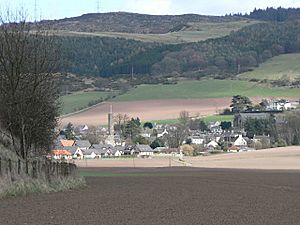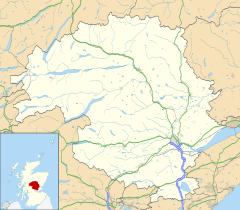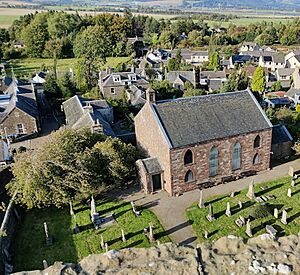Abernethy, Perth and Kinross facts for kids
Quick facts for kids Abernethy
|
|
|---|---|
 The village of Abernethy viewed from the north |
|
| Population | 1,390 (2020) |
| OS grid reference | NO189163 |
| • Edinburgh | 27 mi (43 km) |
| • London | 358 mi (576 km) |
| Council area | |
| Lieutenancy area | |
| Country | Scotland |
| Sovereign state | United Kingdom |
| Post town | PERTH |
| Postcode district | PH2 9xx |
| Dialling code | 01738 85 |
| Police | Tayside |
| Fire | Tayside |
| Ambulance | Scottish |
| EU Parliament | Scotland |
| UK Parliament |
|
| Scottish Parliament |
|
Abernethy is a village and former burgh in the Perth and Kinross council area and historic county of Perthshire, in the east central Lowlands of Scotland.
Situated 8 miles (13 km) south-east of the city of Perth in the area of Strathearn, Abernethy is notable for its Pictish history and mediaeval round tower. The traditional civil parish of Abernethy also contains the nearby settlement of Aberargie and traditionally extends to Mugdrum Island in the Firth of Tay.
Contents
History
Etymology
Abernethy, recorded in the 10th century as Aburnethige, means 'mouth of the river Nethy'. The first element of the name is the Pictish word aber 'river mouth'. The river-name Nethy is from the Celtic root nect- 'pure, clean'. The Nethy Burn flows down from the Ochil Hills past the present village. The Gaelic form of the name is Obar Neithich.
Early history
There is evidence of early settlement in the area, with a Bronze Age log boat being discovered at Carpow in 2001.
A group of Roman sites within the village have been given the name "the Abernethy complex", including a fortress at the top of Castle Law and the site of the former Carpow Roman Fort to the east of the village.
Middle Ages
The village was once the "capital" (or at least a major religious and political centre) of the kingdom of the Picts. The parish church, which sits on land given by Nechtan, king of the Picts, is dedicated to Saint Brigid of Kildare of (fl. 451–525), and the church is said to have been founded by Dairlugdach, second abbess of Kildare, one of early Christian Ireland's major monasteries.
Several pieces of Pictish or early medieval sculpture have been found in Abernethy, including an incomplete Pictish symbol stone attached to the base of the round tower. The location "Afarnach's Hall" referred to in the earliest mediaeval Arthurian literature is usually identified as Abernethy.
Abernethy is believed to have been the seat of an early Pictish bishopric, its diocese extending westward along Strathearn. In the 12th century the bishop's seat was moved to Muthill, then Dunblane, so that Abernethy, no longer being a residential bishopric is today listed by the Catholic Church as a titular see.
In 1072, Abernethy was the site of the Treaty of Abernethy concluded between William the Conqueror and Malcolm III of Scotland.
Abernethy remained the site of a small priory of Augustinian canons, founded 1272. In the 15th century, this priory was suppressed in favour of a collegiate church under the patronage of the Douglas Earls of Angus. Remains of the collegiate church survived until 1802 within the present village graveyard, when they were replaced by the present plain red sandstone church, which is still dedicated to Saint Brigid.
Modern history
Abernethy was granted a charter as a burgh of barony in 1476 by the 5th Earl of Angus, a status confirmed in 1628 by the 11th Earl. The Earl of Angus and Lord Abernethy have become subsidiary titles of the Dukes of Hamilton. It later became a police burgh and held its burgh status and instruments of local government until the Local Government (Scotland) Act 1973.
In the Second World War, the village hosted a camp for Polish forces and was the destination for a number of evacuees. In 2012, the London Olympics torch relay passed through Abernethy as part of its progress around the British Isles.
Culture and community
Abernethy was formerly associated with agriculture, including soft fruit production, salmon fishing and weaving.
A general store is found in the village's Main Street. The local post office was replaced in 2009 with a mobile service. The village also hosts a public house, museum, garden centre, public park and heritage gardens.
A Gala / Fete Day is held annually on the first or second Saturday in June, with a race to the top of nearby Castle Law taking place the following day.
Museum of Abernethy
The Museum of Abernethy in the village opened in May 2000 and is open to the public during May to September each year. It also holds a key to the round tower.
Religion
The village falls within the Church of Scotland's ecclesiastical parish of Abernethy, Dron and Arngask. The village's parish church is known as the Kirk of St Bride and dates to the 19th century, built on the site of a former mediaeval church and on the site of the former monastery.
The former South United Free Church building, constructed in 1866, remains in the village, but has been deconsecrated.
Landmarks
The core of Abernethy is designated as a conservation area, with a number of residential and business premises being listed buildings.
Abernethy Round Tower
The village has one of Scotland's two surviving Irish-style round towers (the other is at Brechin, Angus); both are in the care of Historic Environment Scotland. The tower stands 74 ft (23 m) high, and it is possible to climb to the top, using a modern metal spiral staircase (the tower originally had several wooden floors linked by ladders). The tower was evidently built in two stages (shown by a change in the masonry), and probably dates from the 11th to early 12th centuries.
Abernethy cross
The village's war memorial is modelled on a former market cross and was unveiled in the village's open square in 1921.
Balvaird Castle
The 15th century Balvaird Castle, a mediaeval tower house, is located outside of the village.
Transport
The village is located near the M90 motorway, sitting on the A913 road, connecting to Cupar to the east and onward through the A912 to Perth in the west. There is a bus service to nearby towns.
Abernethy railway station served the village until 1955, when it was closed by the British Transport Commission.
Education
The village maintains a single non-denominational state primary school. Abernethy Primary School's current building was constructed in 2002 and expanded in 2013. In 2023, the school roll was 148 pupils.
See also
 In Spanish: Abernethy para niños
In Spanish: Abernethy para niños




